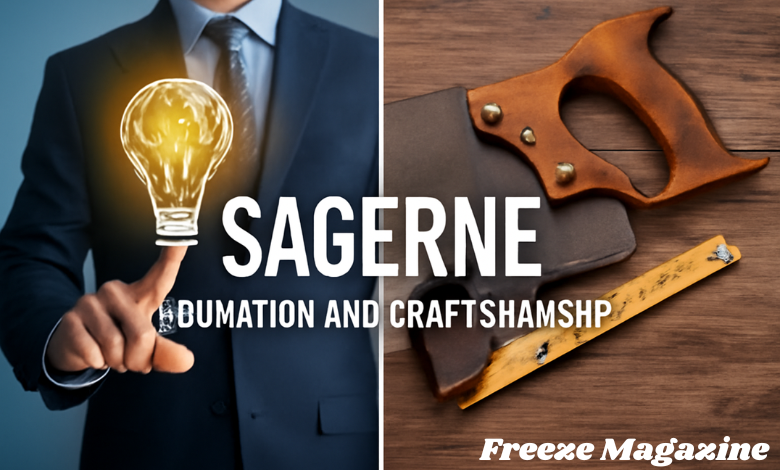Sagerne: Bridging Innovation and Traditional Craftsmanship for a Modern Future
Introduction
The word “sagerne” carries a unique significance, holding meaning in two distinct contexts. In one realm, it represents the tools of craftsmanship, specifically the saws used for cutting materials like wood, metal, and stone. In the other, it serves as a metaphor for innovation, problem-solving, and strategic thinking, qualities that are crucial for success in modern industries. While these two interpretations may seem disconnected at first glance, they both rely on the same core principles—precision, creativity, and skill.
In this article, we explore how the dual nature of “sagerne” can teach us valuable lessons in both the world of business and technology as well as in the field of craftsmanship.
Sagerne in Business and Technology
In the context of modern business and technological innovation, “sagerne” is often associated with strategic foresight and creative problem-solving. These are qualities that businesses, educational systems, and industries rely on to stay competitive and evolve over time. Just as a saw is used to carefully shape raw material into a finished product, a sharp business strategy helps shape a company’s future.
Strategic foresight is essential for success in today’s fast-changing markets. Companies need to anticipate future trends, challenges, and opportunities, and then develop plans to stay ahead. This involves more than just reacting to current conditions—it requires thinking ahead, understanding potential risks, and adapting to change.
Problem-solving is another area where “sagerne” plays a crucial role. In the same way a craftsman uses a saw to transform a piece of wood into a useful object, businesses must use creativity and resourcefulness to turn challenges into opportunities. In technology, this could mean developing new software to address emerging needs or finding innovative ways to improve production processes. These solutions often require thinking outside the box and approaching problems from fresh perspectives.
Finally, creative thinking ties everything together. In the business world, creativity is the driving force behind new ideas, whether that involves developing a new product or finding a more efficient way to operate. It is essential for adapting to new technologies and market shifts. Just as a saw allows a craftsman to create something entirely new from raw materials, creative thinking allows businesses to transform challenges into breakthrough innovations.
Sagerne in Craftsmanship: The Traditional Role of Saws
In a more literal sense, “sagerne” directly refers to saws, which have been an essential part of manual craftsmanship for centuries. These tools are used for cutting and shaping materials such as wood, metal, and stone. Whether it’s a simple hand saw or a more complex power tool, the saw is an indispensable instrument in the world of fabrication, from building homes to creating intricate works of art.
The history of the saw stretches back to ancient civilizations, where tools were crafted to make everyday life more efficient. Over time, the saw evolved into various forms, each designed for a specific purpose, whether that was cutting large beams for construction or carving fine details in wood for furniture making. The design and function of these tools have advanced over time, but the principles of craftsmanship remain the same: precision, attention to detail, and patience.
In the hands of a skilled artisan, a saw can be used not just for its utility, but for its ability to transform raw materials into something functional and beautiful. Whether used in traditional carpentry, sculpture, or even modern construction, the saw is a symbol of manual skill and expertise. It requires not only technical knowledge but also a deep understanding of the materials being worked with and an ability to envision the finished product.
Even with the advent of power tools and modern machinery, many craftsmen still prefer traditional saws for their level of control and the tactile connection they provide with the materials. The art of using a saw has become part of the larger tradition of craftsmanship that emphasizes hands-on skill, attention to detail, and a commitment to quality.
The Intersection of Innovation and Craftsmanship
While the two interpretations of “sagerne”—one as a tool and the other as a metaphor for strategic thinking—might seem unrelated, they are more connected than one might think. Both rely on the same essential principles: creativity, problem-solving, and precision.
The connection between innovation and craftsmanship is often overlooked, but in many ways, the two have always been intertwined. In the past, innovations in tools, materials, and techniques were often driven by the needs of craftsmen. For example, the development of more efficient saws and other cutting tools was essential for improving the speed and precision of fabrication. Today, this relationship continues to evolve as modern technology meets traditional craftsmanship.
Take, for instance, the way digital technology is now being used in traditional woodworking. While power saws have made cutting wood faster and more accurate, computer-controlled machines such as CNC routers and laser cutters have opened up new possibilities for design and precision. These innovations don’t replace the skills of the craftsman; instead, they enhance them. In this sense, technology and craftsmanship work hand-in-hand to create products that are not only functional but also of the highest quality.
This merging of traditional and modern methods is evident in many industries today. In architecture, construction, and manufacturing, for instance, computer-aided design (CAD) software helps architects and builders plan projects with precision, but the physical labor of cutting, assembling, and finishing remains a crucial part of the process. In this way, “sagerne” symbolizes both the past and the future, where old-world craftsmanship meets modern-day innovation.
The Value of Sagerne: Lessons for the Future
In the modern world, where technology often takes center stage, it’s easy to overlook the value of manual craftsmanship. However, the dual meaning of “sagerne” reminds us of the importance of both traditional skills and forward-thinking innovation. Whether we are solving problems in the business world or creating something by hand, the principles of creativity, problem-solving, and precision remain as relevant as ever.
“Sagerne” serves as a reminder that both manual tools and strategic thinking are essential for progress. In business, a sharp mind is just as important as a sharp tool, and in craftsmanship, the right tool can make all the difference. Both require skill, dedication, and a willingness to improve over time.
By embracing both sides of “sagerne,” we can move forward with a better understanding of how old and new can work together. In industries such as manufacturing, construction, and technology, blending traditional craftsmanship with modern innovation offers endless possibilities for growth and creativity. The future of any field, whether business or craftsmanship, depends on finding this balance—taking the lessons from the past and applying them to the challenges of the present and future.
Conclusion
The word “sagerne” represents much more than just saws or tools. It symbolizes the intersection of tradition and innovation, where creative thinking, precision, and problem-solving are essential for success in both business and craftsmanship. By appreciating the value of both the tools we use and the strategies we implement, we can unlock new possibilities for growth and progress in every field. Whether in a workshop or a boardroom, “sagerne” reminds us that the right combination of creativity, skill, and foresight can turn raw materials into something truly remarkable.
FAQS
1. What does “sagerne” mean?
“Sagerne” has two meanings: in Danish, it refers to “the saws,” tools used in craftsmanship, and also symbolizes innovation and strategic foresight.
2. How is “sagerne” related to innovation?
“Sagerne” represents creative problem-solving and strategic thinking, essential for business success, technological advancements, and educational reforms.
3. Why are saws important in craftsmanship?
Saws are fundamental tools in woodworking, construction, and fabrication, allowing artisans to shape materials with precision and skill.
4. How does “sagerne” connect business and craftsmanship?
Both interpretations of “sagerne” involve creativity and problem-solving—whether in strategic business planning or in hands-on craftsmanship.
5. Can “sagerne” be linked to modern technology?
Yes, modern technological advancements, like computer-controlled saws, enhance craftsmanship, blending traditional skills with innovation for greater efficiency.





Post Comment